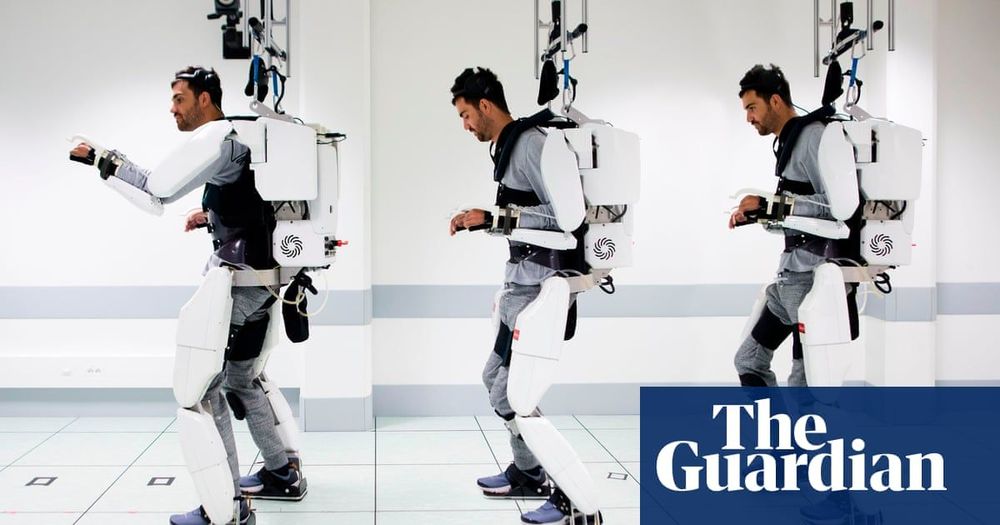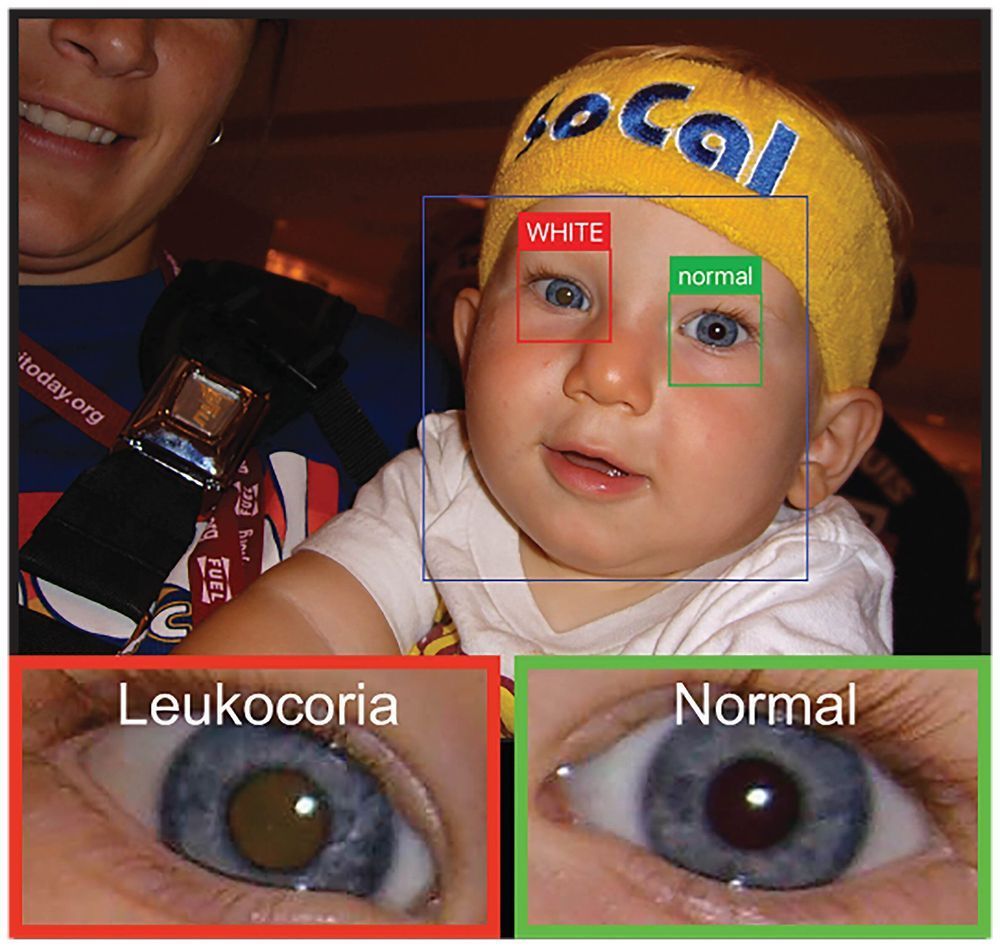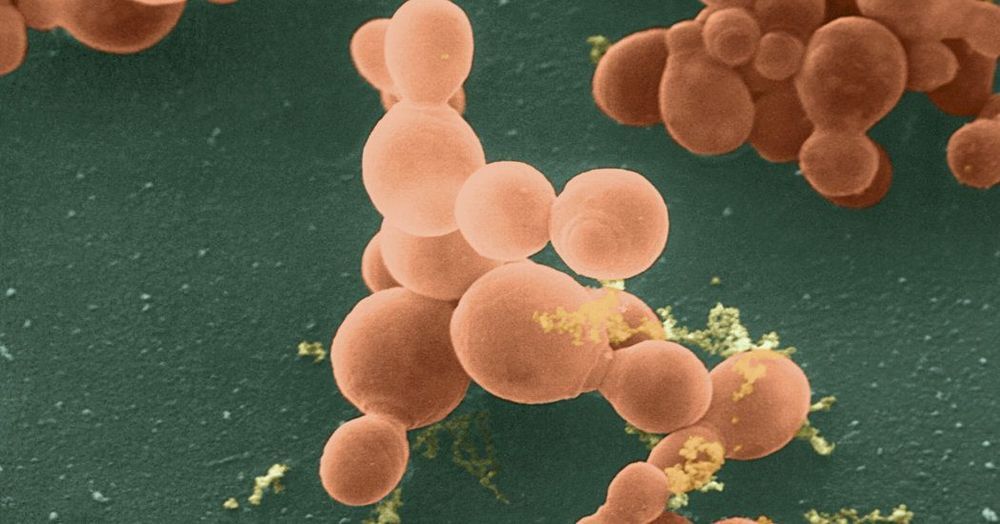Regenerativa no asociada egos narcisistas o cánones de belleza pagada bien doctora liz bien.
Category: biotech/medical – Page 2,571



Paralysed man walks using mind-controlled exoskeleton
A first: paralyzed man uses brain signals to control a robot exoskeleton.
Doctors who conducted the trial said though the device was years away from being publicly available, it had the potential to improve patients’ quality of life and autonomy.
The patient, identified only as Thibault, 28, from Lyon, said the technology had given him a new lease of life. Four years ago his life was permanently changed when he fell 40ft (12 metres) from a balcony, severing his spinal cord and leaving him paralysed from the shoulders down.
“When you are in my position, when you can’t do anything with your body … I wanted to do something with my brain,” Thibault said.
Everything is Code
One of the most astonishing revelations might be that information equals reality. In other words, the basis for our material reality is actually immaterial information. Pattern and flow of information is what defines our experiential reality.
Everything boils down to the binary code of Nature. This is a basic tenet of Digital Physics which is the science of information. Nature computes. Deep down we are information technology. We run on genetic, neural and societal codes. Our DNA-based biology is clearly code-theoretic. We are alphabetic all the way down. We communicate intersubjectively mind-to-mind via language-structured exchange of information.
A recent study shows that human speech is transmitted at about 39 bits a sec. Idealist philosopher Terence McKenna used to say that “The world is made of language and if you know the words the world is made of you can make of it whatever you wish.”

An Interview with Dr. Justin Rebo
At the Ending Age-Related Diseases 2019 Conference in New York City, we had the opportunity to interview Dr. Justin Rebo from the drug discovery biotech company BioAge.
BioAge is developing a drug discovery platform that uses machine learning and artificial intelligence to discover targets that have the potential to promote healthy lifespan (healthspan) by slowing down aging and the ill health that it brings.
As the vice president of in-vivo biology at BioAge, Dr. Rebo leads the company’s internal in-vivo platform to find and assess the viability of new druggable targets for aging diseases and biomedical regeneration. With considerable business as well as academic experience in the aging field under his belt, Justin joined the BioAge team in 2018.

Researchers Discover a Common Medicine May Prevent Harm to Lungs From Air Pollution
A new study is the first to report evidence that nonsteroidal anti-inflammatory drugs (NSAIDs) like aspirin may lessen the adverse effects of air pollution exposure on lung function. The team of researchers from the Columbia Mailman School of Public Health, Harvard Chan School of Public Health, Boston University School of Medicine published their findings in the American Journal of Respiratory and Critical Care Medicine.
The researchers analyzed a subset of data collected from a cohort of 2,280 male veterans from the greater Boston area who were given tests to determine their lung function. The average age of participants was 73 years. The researchers examined the relationship between test results, self-reported NSAID use, and ambient particulate matter (PM) and black carbon in the month preceding the test, while accounting for a variety of factors, including the health status of the subject and whether or not he was a smoker. They found that the use of any NSAID nearly halved of the effect of PM on lung function, with the association consistent across all four weekly air pollution measurements from same-day to 28 days prior to the lung function test.
Because most of the people in the study cohort who took NSAIDs used aspirin, the researchers say the modifying effect they observed was mainly from aspirin, but add that effects of non-aspirin NSAIDs are worthy of further exploration. While the mechanism is unknown, the researchers speculate that NSAIDs mitigate inflammation brought about by air pollution.
Immortality by 2029
A year old, and this video is titled with the “I-word”. But a very interesting talk.
It’s not every day that I get to post a video where I feel like I’m involved with something that may seriously improve and extend lives. I’m so grateful that somehow, I was brought into this process.
The ForbiddenKnowledgeTV newsletter and website attract a large number of physicians and health-practitioner subscribers and it’s been a real joy to make friends with the doctors on my list over the years. One leading physician who first contacted me, way back in August 2011 was Dr. Ron Klatz, Founder-President of the American Academy of Anti-Aging and Regenerative Medicine (A4M).
Last week, he asked me to edit this video of the first round table discussion of the American Association of Stem Cell Physicians, which had been live-streamed on August 11th and which he’d helped to moderate. It was shot completely unstaged and it was very rough-and-tumble and it needed a little cleaning-up. I said sure, without fully realizing what a treat I was in for, with this incredibly dynamic and inspiring group of scientists and physicians; who don’t normally speak to each other – let alone on camera – in a totally live, unscripted setting!
In 1996, Dr. Klatz and the A4M predicted that medical advancements were on pace to achieve life expectancies of 120 years or more, or what they call “Practical Immortality” by 2029. With the latest developments in stem cell technology and nutritional medicine, among others, this prediction is well on track.

App can detect ‘white eye’ in children’s photos to spot possible problems
A team of researchers from Baylor University, with assistance from staff at the Massachusetts Eye and Ear Infirmary, Harvard Medical School and the Dana-Farber Cancer Institute has developed and tested a smartphone app that is able to detect “white eye” in children by analyzing stored photographs. In their paper published in the journal Science Advances, the group describes how the app was developed and tested, and how well it works.
Most everyone has seen pictures of people seemingly possessed by the devil because their pupils glow red—this is caused by light bouncing off their retinas. However, such pictures sometimes produce white instead of red retinas. Sometimes it can happen due to ambient lighting conditions, but other times, it can indicate an eye ailment. Such problems can include retinoblastoma, a type of eye cancer, retinopathy, or even cataracts.
The idea for an app that could detect white eye came from the experience of one of the researchers, Brian Shaw, and his son, who developed retinoblastoma and subsequently lost an eye. The team developed the app and made it available to the public back in 2014, but it was not until more recently that the team decided to test the app to see how well it works.
